Last Updated on December 18, 2021 by Vladimir Vulic
The symbolic bed enthroned in the atrium or tablinum of the Roman house was a reminder that the house was also intended to accommodate a woman destined to become a mother.
Marriage really could either bring a wife into the household following a proper marriage ritual, or merely involved the couple living under the same roof after the signature of a contract. The style of marriage was not really important. It’s function was quite simple; to change a woman’s status from that of a young maid, virgo, to that of a mother, mater
The marriage itself was in fact not regarded as having been fully consummated until the first child was born in the house. Marriage to the Romans was about procreation and nothing else, so it was essential that children should be born inside the house.
There were two types of marriage.
The more conventional -and more ancient form – was a marriage by which the woman became a member of the husband’s family. She lost her family rights of inheritance of her old family and gained them with her new one. She now was subject to the authority of her husband. This was the traditional form of marriage, (conventio in manum).
Alternatively there was the free marriage (sine manu). In this arrangement the wife remained a member of her original family. She stayed under the authority of her father and kept her family rights of inheritance with her old family, though didn’t gain any with the new family.
This was not a traditional form of marriage and it could simply be annulled by the separation of the couple. It was sufficient for the husband to tell his wife, either in person, or by letter, or by sending a slave that the marriage was at an end, for the free marriage to annulled.
However, the free marriage was generally conducted by marriages between noble households, and hence it was unlikely that one side would so openly insult the other. Far more the separation would be conducted upon agreement of both sides.
The bride’s age varied greatly depending on wether it was her first marriage. Roman girls tended to marry very young, though the law prohibited them from marrying below the age of twelve.
In noble families the wedding was often preceded by a lengthy engagement in order to bring the two families closer together. Prior to the wedding the young bride-to-be might go to live with her future husband in his house.
The Marriage Ceremony
The day of a wedding was chosen with great care, to prevent it falling onto a day of bad omens. The superstitious Romans were eager to assure that no bad luck should befall a couple for a a carelessly chosen date for their marriage. May for example was seen as a unlucky month, whilst the second half of June was seen as an ideal setting.
On the evening before her marriage the bride would sacrifice her childhood toys to the lares, the family spirits.
The wedding ceremony saw the bride prepared in her house being disguised under a fire coloured veil (flammeum and dressed in simple white dress, gathered by a belt, tied in a special knot (nodus herculeus) which the groom would have to untie. This she would wear instead of the toga praetexta the garment for girls (as well as boys) she had worn until then.
Throughout the ceremony the bride was accompanied by the pronuba, a matron who had only married once. The ceremony began with a sacrifice and the auspices being taken. After the sacrifice the tabulae nuptiales (marriage contract) was signed, normally in the presence of ten witnesses.
Then the pronuba took the right hands of the couple and placed them in each other. This was the most important moment of the ceremony, the silent exchange of vows between the couple.
The ceremonial over, it was time for the wedding banquet (cena nuptialis).
At the end of the wedding banquet, bringing together the relatives of both families, the bride groom, wresting the bride from her mother’s arms , would pretend to abduct her while she would pretend to resist. This was done traditionally in memory of the rape of the Sabine women.
A procession would then lead the young girl to the husband’s house.
The bride would would accompanied by three boys. Two of the boys held her by the hand, the third walked ahead of her, carrying a torch which had been lit at the fire of the hearth of the bride’s home. The charred remains of the torch were a symbol of good luck and were distributed among the guests, just as today the bride’s bouquet is thrown into the crowd.
The people in the procession would laugh and hurl obscene jokes at the couple. Arriving at the threshold of the house the bride would cover it with strands of wool and smear it with lard and oil (the reasons for this tradition are unclear). Her husband, waiting indoors, would ask her to tell him her forename. Since Roman women did not use the forename, she would, for example, reply, ‘Where you are Gaius, there shall I be Gaia.’
She would then be lifted over the threshold so that her feet would not touch it. Due to Roman tradition only strangers or members of the household would pass through the door. The bride was neither. Until she had entered she was not a member of the household, and yet she was not a stranger. Once through the door she was a part of the family. The tradition has survived to this day, grooms carrying their brides through the door of their home after marriage.
The husband then performed a brief religious ceremony, after which the pronuba seated the bride on the symbolic marital bed which traditionally stood in the Roman house (lectus genialis).
The bride then pronounced the ritual prayers to the god of her new home. With this the ceremony was at an end. The following morning the bride, wearing the matron’s costume – worn by mothers and women in a position to become mothers – would make a offering to the lares and penates(the spirits of the family and of the larder).
Usually she would then also receive presents from her husband. Also a small banquet for the close relatives of the couple would take place (repotia).
There were different ways by which a couple could come to be married.
confarreatio was the sacred ceremony of marriage (originally only found in patrician families) which took its name from the cake (libum farreum) which the couple shared in the ritual.
coemptio was a sale of the of the daughter to her husband. This was originally in early Roman times a genuine method of marrying, but later it became a merely symbolic gesture, as an alternative to the confarreatio ceremony.
usus was the establishment of marriage by the couple living with each other without interruption for a year. This old means of marriage however quickly fell into disuse.
From when she was married, two different fates could await the bride. If she was lucky enough to be fertile and gave birth to three children or more, she would be a respected mother, a wife to be envied and would gain acceptance in the community. If, however, she proved infertile, she would be threatened with repudiation. This was not as bad as it might at first seem. Having returned to her father’s house with her dowry,she might upon his death become an almost free woman who, in time, might even forget her failure as a matron by throwing herself into business affairs and amorous diversions.
Many wives died before either of these destinies could be fulfilled. Childbearing and its aftermath carried of huge numbers of women between the ages of sixteen and thirty-five. The young mothers who died in childbirth form a long list.
From the second century BC onwards, as a result of this imbalance between the number of men wishing to get married and the availability of women capable of becoming mothers, there was in every section of society a sharp increase in the number of divorces and remarriages of fertile women. A wife who had proved herself a good childbearer might thus pass from one home to the next, providing children. Of course, frequent marriage was also a way of the nobility to enlarge the network of its relations and its political backing. But that did not apply to the families of the plebs (commoners) or of the small provincial notables, where divorce and remarriage were just as common as among Roman nobility. Marriage assumed the character of an undertaking between men who lent one another their daughter, sister and even sometimes their wife as a way of ensuring that children were produced.
There are records of many Romans proclaiming that there was nothing worse than marriage, and that, were it not for the necessity to produce children, no one would ever get married. A rich wife was a tyrant and a poor one would spend all your money. So the only Romans who married were those who could not avoid it, men burdened with the responsibility of continuing the family line or those who decided to found one.
Those Romans who had any children generally had several, four or five each, even if they had not all been born in the same house. They were however not the only providers of children to Rome. A great many children were born out of wedlock. Those Roman men who did not get married, and for that matter those who did, generally lived with slaves or freedwomen. The children resulting from such unions could bear their father’s name if he chose to enfranchise them, but they would not automatically adopt his social position. A Roman might so have several children but still fail to produce an heir.
Example of a Roman Marriage (Reenactment)
Here is an example of a Roman marriage, as performed by the reenactors of the Legio XIIII GMV at Carlisle Castle in 2005.
The marriage is in fact being conducted in defiance of the law which outlawed the marriage of soldiers. Yet it is generally believe this law was more honoured in the breach than in the observance.
Here an gnarled old centurion is taking himself a young bride. Perhaps he is already once widowed. No doubt his family see him as a good catch for their daughter, bringing her status in society and a good, steady income, perhaps also a sizeable inheritance in his will. All this would be part of the Roman marriage contract.
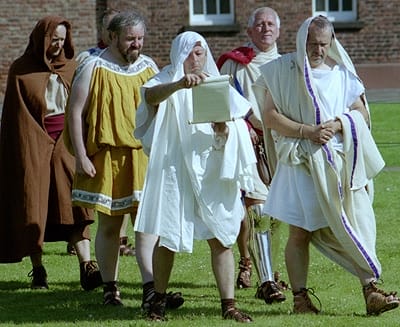
The wedding party arrives, led by two priests, one reading incantations from a scroll as they go.
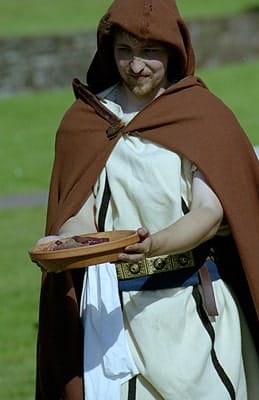
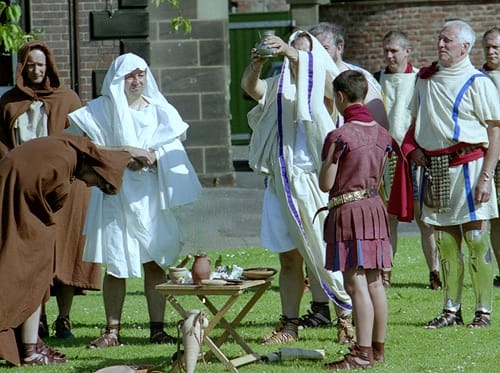
The auspices are taken by inspecting an animal’s liver and wine is proffered to the gods.
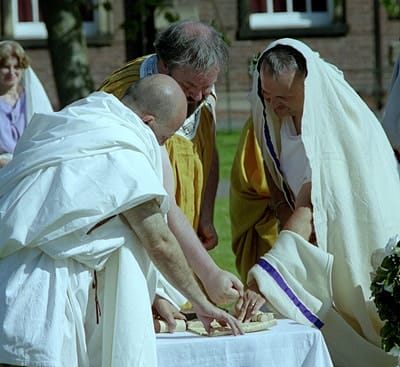
The wedding contract (tabulae nuptiales) is signed. Such weddings could be as much about business contracts than about the wedding itself. One important fact to specified in such a wedding agreement was the dowry, the financial gift to the couple provided by the bride’s family. Importantly, should the couple divorce, the dowry would have to be handed back.
On this picture, the father of the bride places his seal on the document.

The contractual paperwork out of the way, the chief priest begins the ceremonies and leads a prayer to Jupiter Optimus Maximus.
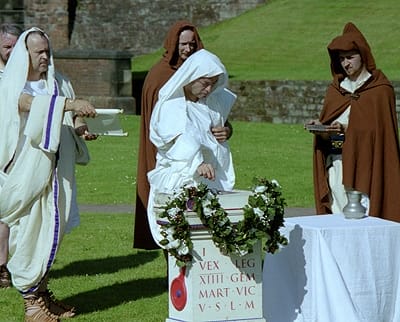
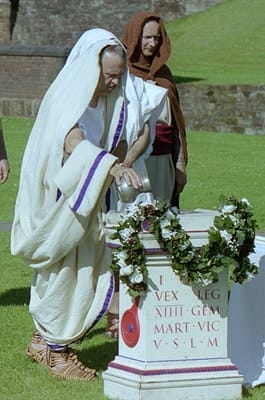
A sacrifice is made by the priests. Sacred cake is crumbled onto a little sacrificial plate on the altar and some wine is poured over it.
The acolytes assist silently in the holy proceedings.
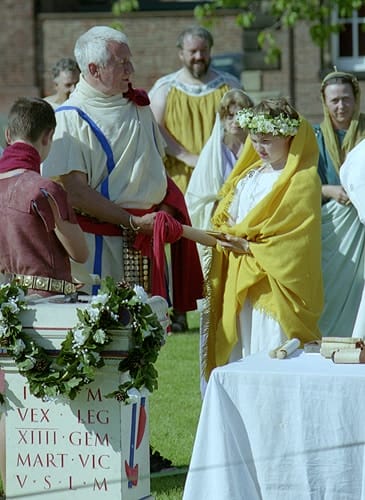
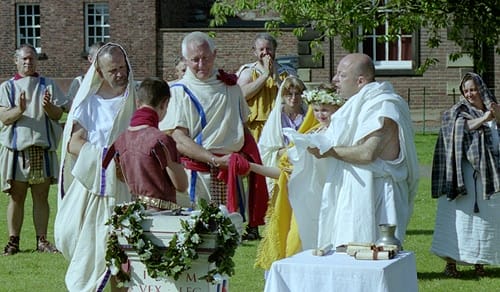
The right hand of both groom and bride are placed in each other and a band is wrapped around them to symbolise their unity.
Finally the priest uncovers his head as a sign that his religious duties at this ceremony are at an end.

The newly-wed pair stand as husband and wife.
If you are surprised at the difference in age, this is much due to the changes our societies have witnessed since then. An age difference such as this one might not have raised eyebrows at all in ancient Roman times.
My thanks to the reenactors of the Legio XIIII GMV for a very interesting display.

Historian Franco Cavazzi dedicated hundreds of hours of his life to creating this website, roman-empire.net as a trove of educational material on this fascinating period of history. His work has been cited in a number of textbooks on the Roman Empire and mentioned on numerous publications such as the New York Times, PBS, The Guardian, and many more.
